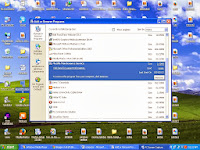Windows XP serves as a platform for
running a variety of software applications. To start an application, click the
start button on the taskbab. The start menu appears. It contains commands to
start programs, open files,change the settings of the computer,search for files and get
assistances on Windows XP.
The list of commands on the start menu
is shown. Some of the commands have an arrow beside them. When you point to
such commands, a submenu appears.
The start menu also bas commands, such
as MY Computer, My Documenys. My Recent Documents, My Pictures and My Music.
My Documents
When you click My documents on the
start menu, the My Documents folder opens. This folder stores all the files and
folders that you frequently access. Ang document you save is automatically
stored in the My documents folder, unless you specify a different location.
My Recent Documents
My Recent Documents displays list of
15 files that you opened recently. To view the list, point to My Recent
Documents on the Start menu. To open a file click it. Windows starts the
application in wich the file was created and then opens the file.
My Pictures
When you click My Picture on the
Start menu, the My Picture folder opens. Picture file such as .jpg, .jpeg,
.gif, bmp, and .png, can be stored here and oraniised as thumbnails for easy
browsing.
My Music
When you click My music on the start
menu, the My Music folder opens. Music files you save can be stored in the My
Music folder.
My Computer
When you click My Computer on the
start menu, the My Computer window opens, this is the most important and
frequently used window on the desktop. It is used to access the drives, folders
and files on the computer.
My Network Places
When you click My Network Places on
the start menu, the My Network Places window opens. This window lists the
computers on the network. In addition, it gives information about resources,
such as folders and printers that are accessible on the network.
Control Panel
When you click Control Panel on the
start menu, the Control Panel window opens. This window is used to customize
the appearance and functionality of your computer. The Mouse icon in Control
Panel is used to change the shape of the standard mouse pointer. The comtrol
panel can also be used to add new hardware and software to your computer.
Printers Faxes
When you click Printer and faxe on
the start menu, the Printer and faxes window opens. This window is used to add
printer and faxes to the computer. You can also change the setting of existing
printers and faxes.
Help and Support
When you click Help and Support on
the start menu, the Help and Support center window opens. This window provides
information about various windows topics. You can click a topic from the list
in the Help and Support center window and get information on that topic.you can
also type the search topic in the search box and get information on it.
Search
When you click Search on the start
menu, the Search window opens. This window is used to search for files and
folder on the computer. If you want to search for a file, you need to type the
name of the file in the box, and then click Search. The Searched files will be
listed in the right pane of the window.
Run
This
command is used to open a file or program directly. To do so type the file name
or the application name in the name box, and click OK.



































